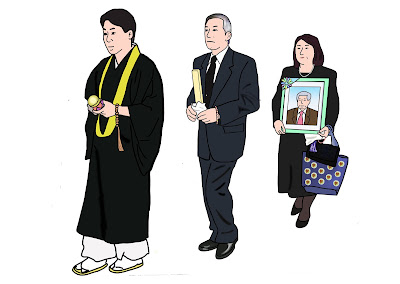Shijukunichi(四十九日) memorial service is a ceremony commemorating the 49th day after someone's death. It is said that Yama(the King of Hell) decides where a dead man is going on the 49th day after his death.
(3)reincarnate as a human,
(4)reincarnate as a creature other than humans,
(5)be a Gaki (hungry ghost),
The dead reincarnate into the above six worlds many times.
We need to prepare a japanned spirit tablet with kaimyo by the day of Shijukunichi memorial service.
 |
| japanned and blank spirit tablet |
On the day of Shijukunichi memorial service, we went to the family temple with the photo, the natural and japanned tablets, the urn. The priest read a sutra, we made an offering of incense at the temple's hall. Buddhist priests hold a ritual to transfer deceased person's soul from natural tablet to japanned tablet and the natural tablet is burnt thereafter.
 |
| sotoba by grave |
 |
| Bonji on sotoba |
 |
| a passage from sutra on sotoba |
Her urn was placed in charnel room under the tombstone. The priest read a sutra in front of the grave. We offered some flowers, burned incense and joined our hands in prayer.
Usually deceased person's relatives go to their family temple, and they have a meal after Shijukunichi memorial service.
My family temple belongs to Shingon Buddhism, but people of all creeds can own their grave on the burial ground of the temple. The burial ground includes Shinto-style graves called "Okutsuki(奥津城)", graves of Korean nationals living in Japan. Shintoism adherents are mostly not allowed to build their graves on the grounds of Shinto shrines because Shinto regards death and blood as Kegare(foulness). The population of Korean nationals living in Japan is about 479,000. Perhaps surprisingly, many people build their graves before their death in Japan.
 |
| Japanese-style grave |
 |
| foreign-type grave |
 |
| foreign-type grave A short epitaph is written on a tombstone. There are no specific rules for epitaphs. |
A surname, "senzo-daidai-no-haka(先祖代々の墓, ancestral tomb)" or a passage from sutras are inscribed on a Japanese-style tombstone. A family crest is also etched.
 |
| senzo-daidai-no-haka |
 |
| A passage from sutras is inscribed on a tombstone |
 |
| We clean our family graves before prayer in the Bon Festival, visiting graves during the equinoctial week |
As of December 31,2019, Shintoism adherents account for 48.6%, Buddhists account for about 46.3%, Christians account for 1.0%, and other religions make up 4.0% of Japan's population, according to a statistical study on religion conducted by the Agency for Cultural Affairs.
At the first bon festival following Shijukunichi memorial service, bereaved families suspend a white paper lantern at their entrance. They prepare the Bon festival, invite relatives and familiar persons, have a Buddhist priest read a sutra at their home. They make a monetary offering(Fuse) to the priest and serve a meal to the visitors. The white paper lantern is used only onetime.
 |
| white paper lantern |
My family temple's priest doesn't visit the houses of the temple's supporters. The temple performs Segaki(施餓鬼), which is a ritual to stop the suffering of the such restless ghosts/monsters as Gaki on August 1st. The deceased's families after more than 49 days after the deceased's death are asked to attend Segaki. The temple's supporters need to pay grave maintenance fee and the donation for segaki every year. At the first bon festival following Shijukunichi memorial service, they need to pay the higher donation for segaki than usual. Due to the COVID-19 pandemic, Segaki was performed behind closed doors for the second straight year. The priest posted video footage of him reading a sutra on YouTube.
The period of mourning after the death of a parent lasts one year. So our family members won't observe the New Year's festival and won't send New Year's cards.
On the first anniversary of one's death, The deceased's family will invite relatives and familiar persons. A Buddhist priest will read a sutra, they will an offering of incense at the temple's hall. Then they will visit the family grave, offer some flowers, and burn incense at the grave and serve a meal to the visitors.
On the first anniversary of my mother's death, only my family members will visit my family grave.
On the second, 6th, 12th, 16th, 22nd, 26th, 32nd, 36th, 49th anniversary of death, a memorial service is performed. However people tend to skip the events of the subsequent anniversaries. Our family performed a memorial service on the 6th anniversary of my father's death and skipped it on the subsequent anniversaries.
On the first and second anniversary of death, mourners wear a mourning cloth. Woman mourners are allowed to wear pearl accessories. Very few people wear a mourning kimono. On the subsequent anniversaries, they wear sober clothing.
 |
| We join our hands in front of a Buddhist altar, having juzu(Buddhist rosary) in our left hand |
 |
a woman in a mourning kimono who has a pail for grave visit and a man holding a cinerary urn |
 |
| mourning attire for men |
 |
| Shinto altar |
 |
| Shinto altar |
The mirror's replica is placed on the top tier of the altar, and the deceased's photo is on its middle tier. Rice, salt, sake(酒), water, kagami-mochi(round rice-cake), sea fish, eggs, vegetables, fruits, confections, dry food are placed on its bottom tier. A pair of Cleyera japonica (sakaki) with five color banners stand on either side of the altar. The sword's replica in cloth case is hung up on the left sakaki. The jewel's replica is on the right sakaki.
 |
| A Shinto priest talks about the deceased's background, offers tributes to him/her, wishes him/her to become a guardian deity of his/her home, and recites religious speeches |
 |
| Tamagushi-houten(玉串奉奠) Attendants offer tamagushi |
 |
 |
| Shinto priest |


































